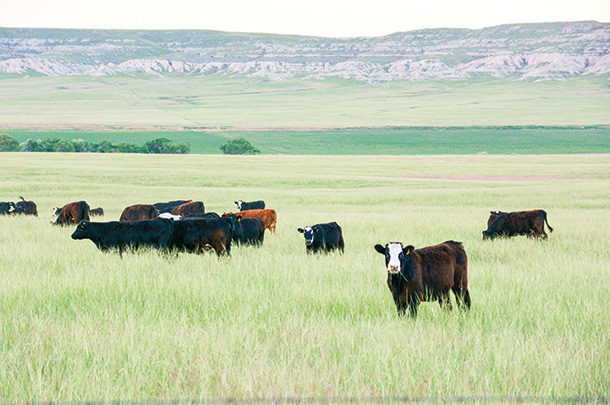Grasslands are a key component of the livestock industry, with feed constituting the greatest annual cost to livestock producers. Understanding the forage resource is essential for effective and profitable grassland livestock management.
However, being able to identify every single plant in your pasture is likely not necessary. Instead, focus on identifying core desirable and the most common undesirable species and their key characteristics.
Soil type, climate and management history dictate plant community composition. Species vary in desirability as determined by goals for the property. If livestock production is the primary goal, species high in nutrient quality that produce the most biomass are likely the most desirable. Time of year can also influence desirability of species, depending on grazing preference or wildlife habitat structure.
Undesirable species include state or county noxious weeds but also may include overabundant, low-quality native plants that are promoted by historical events or management. Review noxious and threatening weed lists in your state and area, as well as in neighboring states where invasions often originate.
Resources such as the USDA Ecological Site Description database, USDA staff and extension personnel are available to help identify current and potential plant communities. These resources can also assess if any desirable species known to exist in the area are missing from the current plant community.
Grazing tools
If the plant community lacks certain desirable species, or if undesirable plants comprise a significant portion of the community, this may be the result of current or past management.
Developing a planned grazing system that promotes desirable species and provides a competitive advantage over invasive, undesirable species can help move grasslands toward desired goals. Management strategies accounting for natural disasters mitigate further negative impacts to desirable species that invasive plants often take advantage of.
Managing to promote desirable plant health and vigor avoids overgrazing and prevents growing-season grazing events at the same time in consecutive years.
These strategies are accomplished using a grazing system with multiple pastures where plants in a grazed pasture can rest and recover while livestock graze a different pasture. Avoiding grazing a pasture at the same time during the growing season in consecutive years will help give desirable plants the opportunity to maintain or improve productivity.
The same strategy can be used in an opposite manner to manage against undesirable species. In general, plants are most susceptible to grazing or drought when actively growing from growth initiation to seed production.
Overgrazing (grazing a plant multiple times before they recover from a previous grazing event) before seed production reduces plant vigor and the number of seeds produced.
Monitor livestock grazing selection to prevent overgrazing desirable species when grazing selection shifts from undesirable species as they reach maturity or availability decreases. The use of temporary fencing can confine animals to a patch of undesirable species and help target grazing to specific plant species by limiting animal grazing options.
Keys of identification
Plant ID can be used to regularly monitor desirable and undesirable species’ abundance in conjunction with monitoring records to track changes over time and assess whether management is having the intended response. Grassland monitoring identifies threats of invasive or undesirable species, providing early detection and the opportunity for rapid response to minimizing impact and spread.
Plant identification is a valuable skill for managing and monitoring grasslands that does not have to be daunting. First, learn to identify the most important plant species.
Then, understand their key characteristics and how management can exploit them in favor of the operation’s goals. Once the skill to distinguish plant characteristics is developed by learning to identify key species, identifying additional species becomes much easier.
Many plant identification publications are available, including Weeds of the Great Plains and North American Wildland Plants, that often include characteristics of each species, such as grazing value.
Other state and region-specific publications are available online, such as “Common Grasses of Nebraska,” “Common Forbs and Shrubs of Nebraska” and “Nebraska Plants Toxic to Livestock,” among others.
Noxious and watchlist weeds are often found on states’ Department of Agriculture websites. Check with local USDA, extension or Department of Agriculture staff for recommendations on plant identification resources for your area.









